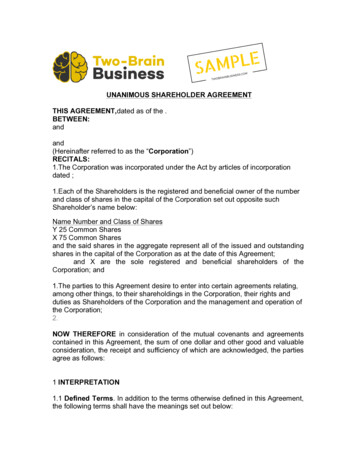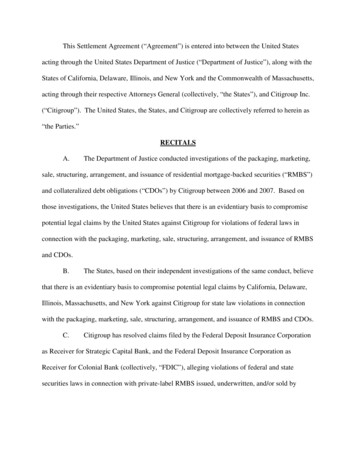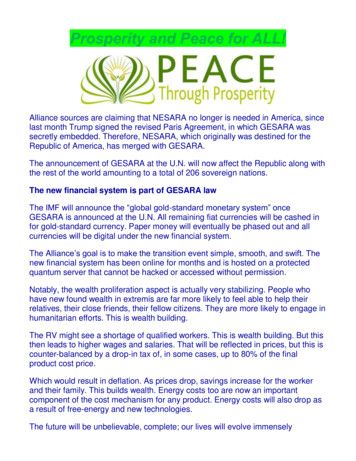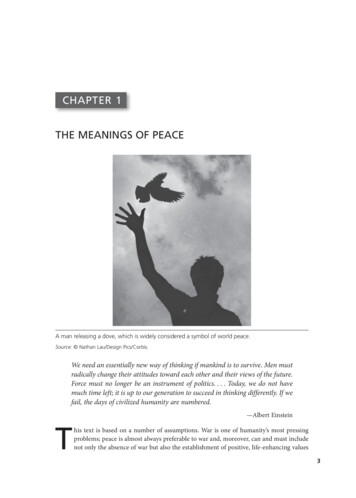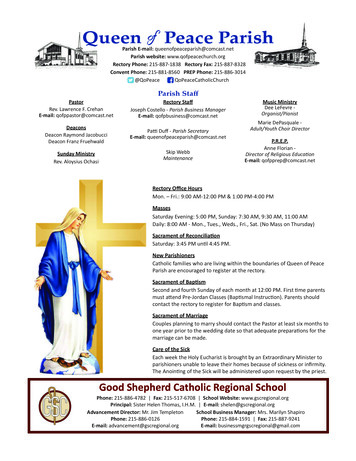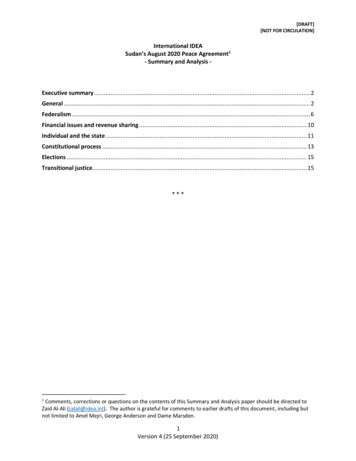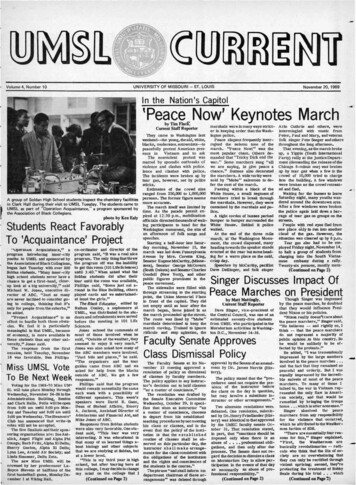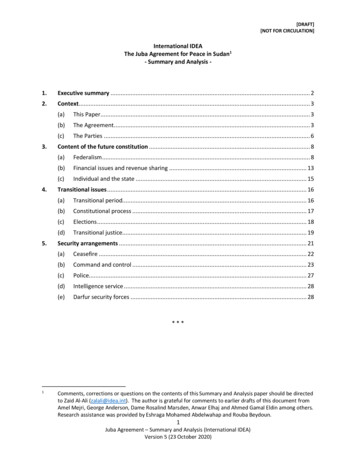
Transcription
[DRAFT][NOT FOR CIRCULATION]International IDEAThe Juba Agreement for Peace in Sudan1- Summary and Analysis -1.Executive summary . 22.Context. 33.4.5.(a)This Paper. 3(b)The Agreement . 3(c)The Parties . 6Content of the future constitution . 8(a)Federalism . 8(b)Financial issues and revenue sharing . 13(c)Individual and the state . 15Transitional issues . 16(a)Transitional period. 16(b)Constitutional process . 17(c)Elections . 18(d)Transitional justice. 19Security arrangements . 21(a)Ceasefire . 22(b)Command and control . 23(c)Police. 27(d)Intelligence service . 28(e)Darfur security forces . 28***1Comments, corrections or questions on the contents of this Summary and Analysis paper should be directedto Zaid Al-Ali (zalali@idea.int). The author is grateful for comments to earlier drafts of this document fromAmel Mejri, George Anderson, Dame Rosalind Marsden, Anwar Elhaj and Ahmed Gamal Eldin among others.Research assistance was provided by Eshraga Mohamed Abdelwahap and Rouba Beydoun.1Juba Agreement – Summary and Analysis (International IDEA)Version 5 (23 October 2020)
[DRAFT][NOT FOR CIRCULATION]International IDEAThe Juba Agreement for Peace in Sudan2- Summary and Analysis -1. Executive summaryOn 3 October 2020, Sudan’s Transitional Government and representatives of several armed groupssigned the ‘Juba Agreement for Peace in Sudan’ (hereinafter ‘Juba Agreement’). The main elementsof the Agreement can be summarized as follows:(i)(ii)(iii)(iv)(v)Sudan is to be established as an asymmetric federation. The Agreement contains a largeamount of detail on the powers that specific regions will exercise, but is close to silent onthe national government’s structure and on the powers that the remaining regions willexercise. These issues will have to be resolved during or before the constitutional process.Much is left to be resolved through legislation (including for example, the internal structureof federal regions and the composition of revenue sharing commissions). These issues andothers will have to be resolved in the coming weeks and months.Significant additional detail has been added to how the constitutional process will beorganized. A conference on the system of government, for which a timeframe and anagenda have been set and some indication on the participants is also given. However, thenature and precise purpose of the conference was not established.The Agreement establishes a complex web of transitional justice mechanisms, includingtruth and reconciliation mechanisms, investigations and the possibility of pardons. In somecases, the Agreement appears to prioritise judicial mechanisms over reconciliation, althoughthat is not stated explicitly.The Agreement also provides for extensive transitional security arrangements, which arealso not organized centrally. Each part of the country will have its own mechanisms andinstitutions. The Agreement also provides that individual members of armed groups shouldbe integrated into the national security forces. The interaction between these differentmechanisms will be difficult to manage.Because of the manner in which the negotiations have taken place, there is good reason to believethat the parties will likely reach agreement on these outstanding issues. The challenge however willbe to create an effective system of government for the general population that enjoys some form ofdemocratic legitimacy while continuing to make progress on interim governance issues within areasonable timeline.2Comments, corrections or questions on the contents of this Summary and Analysis paper should be directedto Zaid Al-Ali (zalali@idea.int). The author is grateful for comments to earlier drafts of this document,including but not limited to Amel Mejri, George Anderson and Dame Marsden. Research assistance wasprovided by Eshraga Mohamed Abdelwahap and Rouba Beydoun.2Juba Agreement – Summary and Analysis (International IDEA)Version 5 (23 October 2020)
[DRAFT][NOT FOR CIRCULATION]2. Context(a) This PaperSubstantive focus. This Paper is mainly focused on the Agreement’s constitution buildingelements (meaning its impact on Sudan’s constitution building process and on the futureconstitution’s substantive content). Aside from the constitution building elements, the Paperalso includes some discussion of the general context in which the Agreement was entered into,and summarises some the Agreement’s other elements as well (including securityarrangements, transitional justice and others).Live document. The Juba Agreement is highly complex. The different chapters interact witheach other in ways that are difficult to appreciate from a first reading. The process of readingand rereading the Agreement, and the implementation process will draw attention to provisionsand arrangements whose importance are not immediately obvious today. As a result, thisSummary and Analysis Paper will remain live, meaning that it will be regularly updated to takeinto account subsequent developments.Version 5. This version of the Summary and Analysis Paper introduces a number of changes toearlier versions, including but not limited to the following:(i)(ii)(iii)(iv)The entire document was updated to reflect the fact that the individual agreements thatwere signed in August 2020 were brought together as a single agreement on 3 October2020;The contents of Chapters 4-7 have been incorporated into the summary and analysis;An entirely new section on security arrangements has been added and the section ontransitional justice has been significantly expanded; andEarlier versions of this Paper indicated that the constitutional conference should beorganized within six months of the Agreement’s entry into force. This has been clarifiedin the Agreement’s Implementation Matrix and so the relevant passage in this Paper hasbeen corrected (see page 17).(b) The AgreementThe negotiations. The negotiations that led to the adoption of the Juba Agreement weremediated by the Republic of South Sudan. According to individuals who were involved in thenegotiations, the mediators approached their mediation role with a relatively light touch. Thesubstance of the Agreement was largely negotiated between the Sudanese themselves, withsome limited logistic and technical support from the international community. The negotiationswere also partially defined by the fact that many of the negotiators from the two sides werepreviously comrades in opposition to the former ruling party, which made the act of reachingagreement much less challenging than in past rounds of negotiations.The Agreement(s). The Juba Agreement includes ten different chapters. The first is anagreement on national issues. Six chapters consist of bilateral agreement between theGovernment of Sudan and different armed groups. These different chapters cover a wide rangeof issues, including power sharing, revenue sharing, transitional justice, transitional security3Juba Agreement – Summary and Analysis (International IDEA)Version 5 (23 October 2020)
[DRAFT][NOT FOR CIRCULATION]arrangements. The Agreement also includes an implementation matrix that sets outimplementation deadlines for a very large number of issues.TitleGeographic scopeScopeChapter 1The Agreement on NationalIssues (hereinafter “ANI”)NationalPower sharing, administration of thenational capital, nationalcommissions, the constitutionalconference, the conference onsystem of government, judicialreform, elections, other issues(environment, Christians andmembers of other faiths, anti-racismlegislation, etc.)Chapter 2NationalDarfur Peace Agreement(hereinafter “DarfurAgreement”).North Darfur, SouthDarfur, West Darfur, EastDarfur, Central DarfurPower sharing, revenue sharing,permanent ceasefire, transitionalsecurity arrangements, transitionaljustice, compensation, etc.Chapter 3Two Areas Peace Agreement(hereinafter the “Blue Nileand Kordofan Agreement”).NationalBlue Nile, SouthKordofan, West KordofanAllocation of responsibilities, financialresources, civil service reform,reconstruction and development,environment, etc.Chapter 4Eastern Path PeaceAgreementNationalEastern region (Red sea,Gedaref and Kassalastates)General principlesBasic rights and transitional justicePower sharingSocial, health and economic issuesChapter 5Northern Path PeaceAgreementNationalNorthern region(Northern state and RiverNile state)General principlesSystem of governmentDisputed territoriesCultural, economic and health issuesChapter 6Central Path PeaceAgreementNationalCentral Region(Khartoum, Jazeera,White Nile, and Sinarstates)Agriculture and economic issuesNational fund for developmentChapter 7Agreement on securityarrangements betweenSudan’s transitionalgovernment and the thirdfront – Tamazeg (the “ThirdFront Security Agreement”)National“All parts of the countrywhere the Tamazeg arelocated”Permanent ceasefireCommand and controlReintegrationPolice reformIntelligence serviceDemilitarisation4Juba Agreement – Summary and Analysis (International IDEA)Version 5 (23 October 2020)
[DRAFT][NOT FOR CIRCULATION]TitleChapter 8Geographic scopeScopeStatus of the parties and of theagreements; binding nature of theagreement; status of new parties;dispute resolutionNationalFinal provisionsComplexity. The Juba Agreement is highly complex mainly because of the way in which thedifferent chapters relate to each other. This is to be expected given their overall length andgiven the difficulty that necessarily arises when managing such a complicated negotiationprocess. However, there is an added level of complexity that stems from the fact that each ofthe bilateral agreements has national level implications. The drafters made an effort toconsolidate provisions relating to some areas in the same sections in some of the individualagreements, but this was not done systematically, which makes the agreement more difficult toread and understand. For example:(i)(ii)(iii)On revenue sharing, Section 2 of the Darfur Agreement provides for key arrangementsthat will impact the country as a whole, including those parts of the country that did notsign on to these particular bilateral agreements;On the composition and functioning of national level institutions, readers will have toread hundreds of provisions that are set out in individual bilateral agreements in orderto develop a full understanding of how these institutions will function. This applies to arange of institutions, including governance, security and transitional justice institutions;On the constitutional process, relevant provisions are spread throughout the documentrather than being concentrated in a single section.What this means is that we may discover more and more about the agreement as we continuereading and rereading it. It may also be the case that the signatories may discover that some ofthe arrangements are not compatible with each other, or that they are not particularly happywith the arrangements that they did not sign on to. Where there is great distrust between theparties, this can be majorly problematic and can contribute to a breakdown of the entire peaceprocess. In this case, time will tell whether the new revolutionary atmosphere has createdenough good will between the parties to overcome these problems as they occur.Legal status. Virtually all of the agreements make reference to the 2019 Constitutional Charter.Many reconfirm the relevant signatories’ commitment to the Charter’s section on rights andfreedoms. At the same time, some of the individual documents go further and purport tosubstantially amend the Constitutional Charter’s contents. In particular:(i)(ii)The Blue Nile and Kordofan Agreement provides that its provisions are part of the 2019Constitutional Charter (Article 112). The wording on this point is actually very
Amel Mejri, George Anderson, Dame Rosalind Marsden, Anwar Elhaj and Ahmed Gamal Eldin among others. Research assistance was provided by Eshraga Mohamed Abdelwahap and Rouba Beydoun. [DRAFT] [NOT FOR CIRCULATION] 2 Juba Agreement – Summary and Analysis (International IDEA) Version 5 (23 October 2020) International IDEA The Juba Agreement for Peace in Sudan2 - Summary
